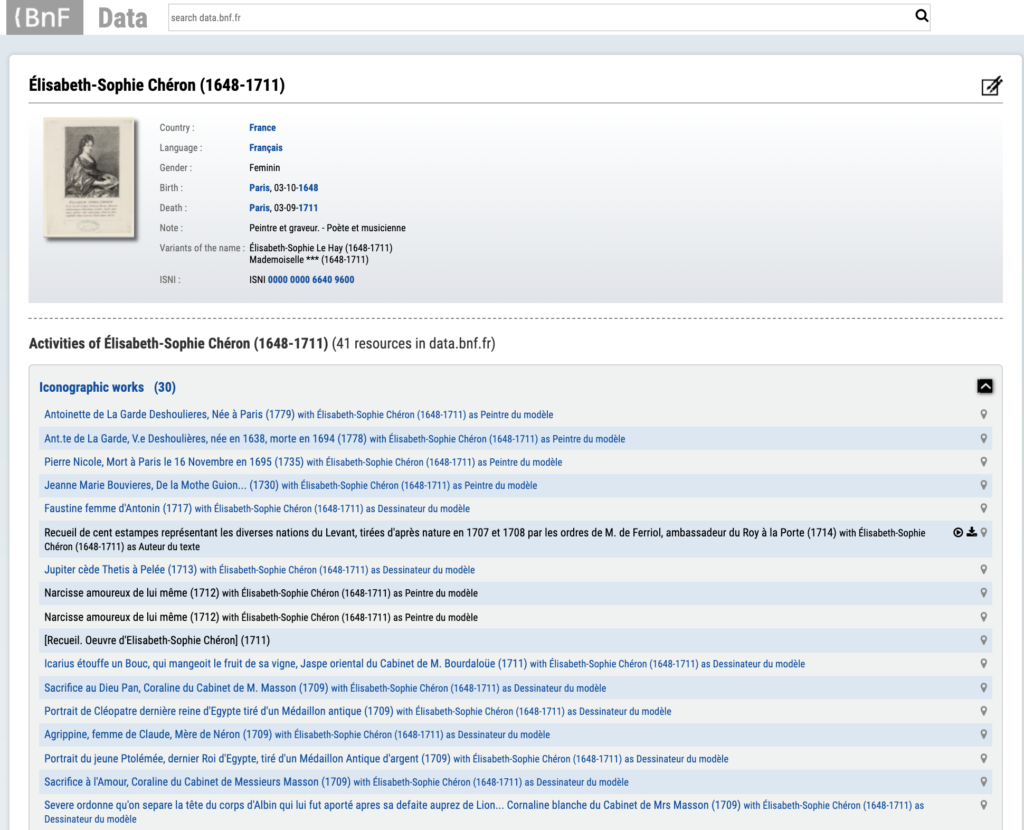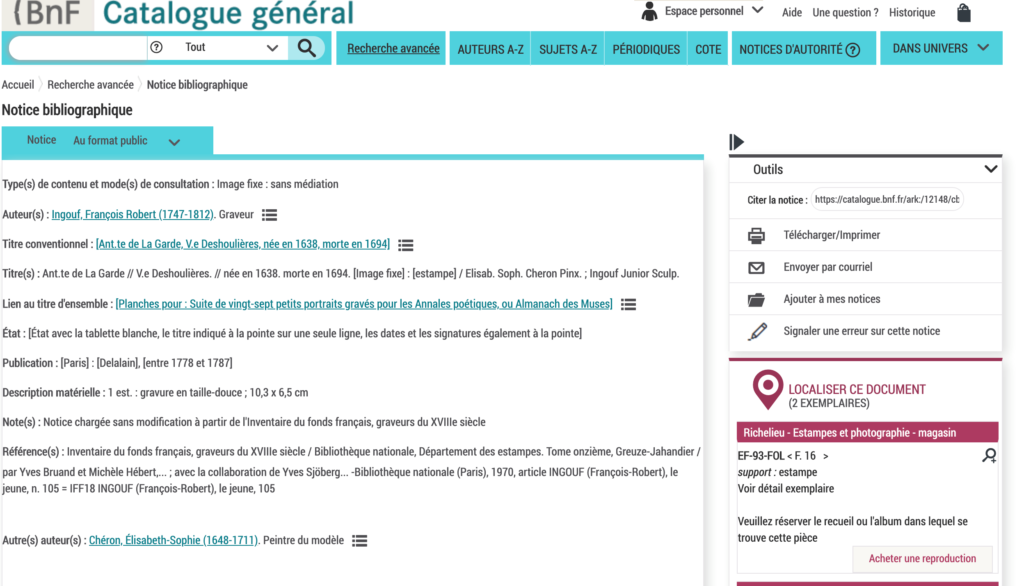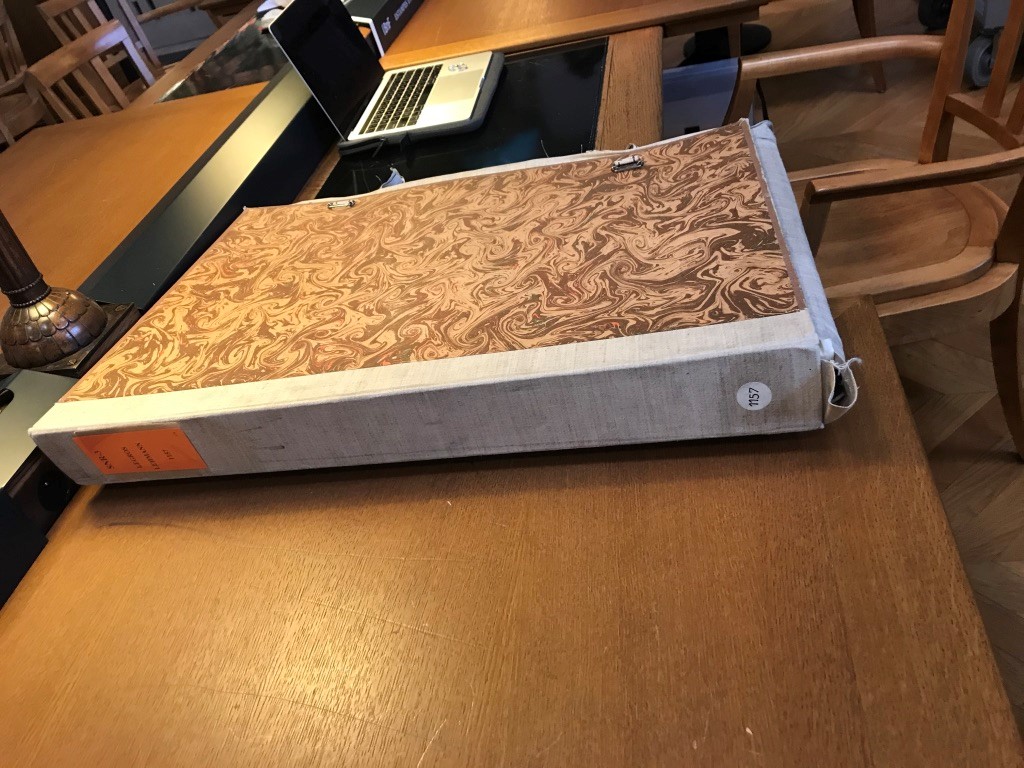Each month, a researcher shares their experiences of using a particular archive. The overall aim of this section is to create a database of the different archives available to those working on French and Francophone studies that will be of help particularly to students just starting out in research.
Kelsey D. Martin is an Art History PhD candidate at the University of North Carolina and works-on-paper curator. Here she offers a detailed guide to working in the Département des Estampes et de la photographie at the Bibliothèque nationale de France.
The Département des Estampes et de la photographie (a department of the Bibliothèque nationale de France) is the premier archive for historians of French works-on-paper. Touted as “la plus grande collection d’images au monde,” the department holds more than 15 million iconographic documents ranging from drawings, prints, photographs, posters, postcards, fabric samples, playing cards, and more. They also conserve various textual materials such as books, periodicals, and sales catalogues. With such abundance of primary source material, an extensive online catalogue, and the Richelieu site’s ongoing renovations, it can be difficult to know where to start when interested in the BnF’s Département des Estampes et de la photographie! Below is a general guide to this particular department, including a step-by-step process for requesting and viewing iconographic prints, recueils, books, and folios.
First, some important general information (more in-depth information can be found here):
- The Département des Estampes et de la photographie is located at the Site Richelieu (58, rue de Richelieu) in the 2nd arrondissement.
- Richelieu is undergoing renovation but remains open to the public. Currently, the Département des Estampes et de la photographie is located in the INHA Library, within the “Salle Labrouste” (the Labrouste Room).
- The library is open Monday—Friday from 9am—7:30pm and Saturdays from 9am—6:30pom.
How to use the BnF’s Département des Estampes et de la photographie in 20 steps:
Getting to the Département des Estampes et de la photographie:
- The entrance to the INHA Library can be found in the center of the building off the Rue de Richelieu, just across from the Square Louvois. You must first walk through security (which includes your standard metal detector and bag check) and then enter the building on your right, past the small courtyard. Directly in front of the entrance are the doors to the INHA Library.
- Before you enter the INHA Library, you must have a research pass. To the left of the entrance doors are several kiosks with attendants who will help you purchase a pass. You must be over 18-year-old and show proof that you are conducting academic, professional, or personal research. A basic letter (in French) from an advisor or department chair works just fine. You can purchase a short-term or long-term pass (for detailed information, click here). The attendant will ask you basic information such as where you are from, what you are studying, and why you are there. You then move to another room at the end of the hall to take your picture and, voila! You now have a pass.
- Lockers are available near the bathrooms. You must have €1 or €2 to use the lockers, which is returned to you after your stay. You can grab a clear plastic briefcase to place your belongings in and then head to the library.
- At the entrance to the Salle Labrouste, scan your new research pass against the card reader and the doors will open. Don’t forget a friendly “bonjour!” to the attendant, who is always pleasant and happy to see students and researchers.
- Take in the view, the Salle Labrouste hosts one of the most beautiful libraries in Paris!
- Head to the center of the library where the reference desks are. Currently, the Département des Estampes et de la photographie librarians are sitting to the left of the reference desk with a sign indicating that you’re in the right spot. Say hello, that you’re here to view some prints, and hand them your card. The librarian will then give you a placard with a number on it, which you then must give to the attendant who oversees the “reading room” (a space located just behind the reference desk where researchers can view documents). The attendant will point you to your numbered space.

Requesting items—come prepared!
- I like to do my research beforehand and come with a list of items I’d like to request for the day. There are many ways to do this, but my preferred method is the following. For clarity, I will pretend I am interested in looking at prints and texts related to the 18th-century French artist and academicienne, Élisabeth Sophie Chéron.
- Use the BnF’s Data catalogue, which aggregates information scattered among its various catalogues and Gallica onto dedicated HTML pages.
- Type in the name of the person or item you’re interested in researching and go to their profile page. It should look something like this:

- The links of various iconographic and textual works listed under profile will take you to their corresponding entries in the BnF Catalogue général. For example, if you click on the link 10th from the top (a recueil related to the works of Élisabeth Sophie Chéron), the corresponding catalogue page will look like this:

- Notice the location of the document in the pink square towards the bottom right. The module will tell you whether the document is at Tolbiac, Richlieu, or another location, and give you the reference number. It will also tell you whether the item has already been digitized and made available on Gallica (the BnF’s digital library), if you can reserve the item on site, if it must be seen in microfilm, or if it must be reserved by email. In the example above, the recueil is listed as item DA-52, which can be “réserver sur place” (reserved on site) at Richelieu in the Département des Estampes et de la photographie. I write down all of the reference numbers I want to review on a given day and bring them with me to the BnF.
Requesting items—you’re in the library, now the fun part!:
- At the moment, you can only request items from the Département des Estampes et de la photographie on-site unless they are special réserve items, which must be booked via email and can only be viewed on Tuesdays and Thursdays from 10am—1pm. There are computers next to the library reference desk that will automatically take you to the BnF’s Catalogue général.
- Take out your list and type in the reference number, author, title, or other keywords into the search bar to locate the work you are interested in viewing. If requesting an entire folio, book, or recueil like the example above, the “réserver sur place” button in the location module will be highlighted and will take you through the appropriate steps. You may reserve up to 10 items a day.
- NOTE: you cannot request single iconographic items (such as an engraving) from a folio or book. The location module within the Catalogue général for that particular iconographic item will tell you to find the larger compendium the item belongs to (see below). Unfortunately, there does not seem to be an easy way to do this. You may intuitively try to click on the titre d’ensemble, but this will only take you to more listings of work by Chéron in the compendium. Instead, you must use the reference number provided to try to find the larger folio within the general catalogue, which can often be difficult to pin down without additional keywords. In the example below (an entry for a print by or after Chéron located within the Almanach des Muses), you would want to search for “EF-93-FOL” (the folio that contains the Almanach des Muses) and “Ingouf” (the name of the author of the Almanach des Muses). If you get stuck, ask a librarian for help!

- After reserving your items, go to your numbered place and wait patiently for the archivists to bring them from storage. I have never waited more than 15 minutes. They will wheel them to you on a trolley and help you pick up heavier items if needed.

- You may handle all items on your own without gloves unless they are special-request documents, such as the items listed with reference numbers “SNR” (see picture below, to the right). These are typically boxes with loose-leaf prints that must be requested beforehand via a handout the librarian will provide. The archivists will provide rubber gloves to handle these documents.


- Have fun!
- When you’re finished, tidy up your space, retrieve your placard from the “reading room” attendant, and return the placard to the librarian at the reference desk, who will then hand you back your research pass.
- Retrieve all items from your locker (and your euros!).
- The BnF Richelieu site is surrounded by some of the best Asian restaurants in Paris—reward yourself with some noodles!

Kelsey D. Martin is an Art History PhD candidate at the University of North Carolina and works-on-paper curator. She is currently based in Paris as a Georges Lurcy Fellow, where she is conducting an extensive recovery project on women printmakers of 18th-century France—the topic of her dissertation.
Thank you very much for this, Kelsey!


